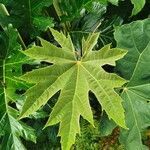A small tree up to 3-6 m tall. It spreads 4.5 m wide. It has stolons or runners. It has a dense woolly or hairy covering. The leaf blade is almost round and with 7-12 lobes. This extend about halfway to the centre. The leaves are 15-30 cm long and densely hairy underneath. The lobes taper. The leafy structures or stipules are 5-12 cm long. They join to the base of the leaf stalk. The male flowers are on stalks 3-5 mm long. These are 6-8 mm long in female flower heads. The petals are triangle shaped and 2 mm long. The fruit is round and flattened. It is about 2 mm long. It is purplish-black.



